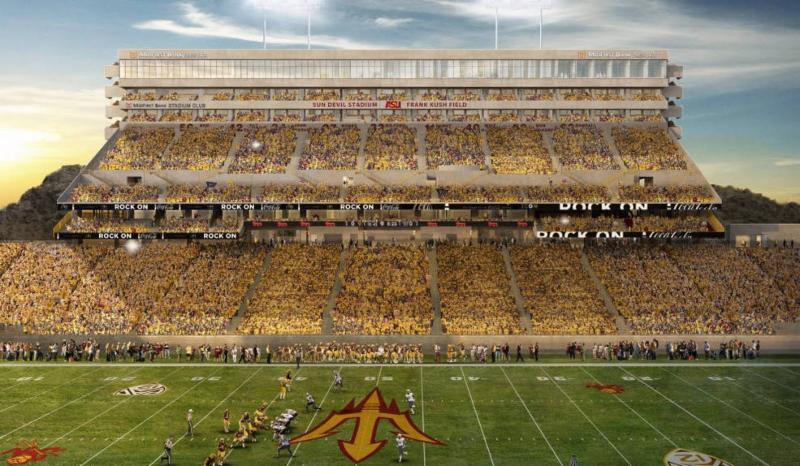Over the past year, numerous college football programs either completed or took steps toward major renovations to their stadiums. As a result, 2016 was not only a year that kicked off new eras for several venues, but marked a major turning point for the futures of many others.
Leading up to the 2016 college football season, one of the most notable projects in the works was the renovation to Sun Devil Stadium. With the project beginning after the 2015, Arizona State University completed the second phase of a three-phase overhaul to the venerable venue this summer, with much of the work focusing on the stadium’s west side.
Changes to the seating, accessibility, concourses, and technology allowed Sun Devil Stadium to inch closer to the future that the university is envisions. That objective was discussed in our June preview of the renovations:
This phase represents a major step towards the university’s long-term vision for the facility. While Sun Devil Stadium has served the university well in its now 58-year history, it has not been significantly enhanced since the 1980’s, when adjustments were made to accommodate the NFL’s Arizona Cardinals.
Its age, combined with the increasingly-competitive landscape that is college football stadium construction and development, made Sun Devil Stadium ripe for upgrades. And while most of these enhancements take the typical approach of addressing fan amenities as well as investing in better player facilities, the Sun Devils want the stadium to become a year-round destination for the university and the Tempe community at large.
In October, it was revealed that ASU would focus on other stadium amenities and hold off on phase three of the Sun Devil Stadium renovation—which will now be completed prior to the 2018 season as opposed to 2017. However, Sun Devil Stadium is still well on its way to a new era.
While it was more associated with the NFL and the Miami Dolphins, the overhaul of Hard Rock Stadium also benefitted the University of Miami. Prior to the 2016 college football season, Hard Rock Stadium received a new canopy over its seating bowl as well as four new videoboards, projects that came as the result of the second phase of the stadium’s renovation.
Elsewhere, the debut of the latest renovations to Gaylord Family Oklahoma Memorial Stadium was met with an overwhelming reception, as the University of Oklahoma set a new attendance record on September 10. Duke University rolled out upgrades to Wallace Wade Stadium, and work continued at Notre Dame Stadium.
The year also gave us some renovations to look forward to down the road, as schools such as the University of Arkansas, University of Tennessee, University of Iowa, and many others conducted crucial votes for future upgrades. Penn State University also generated some headlines, continuing discussions about a major overhaul to Beaver Stadium.
With trends such as new premium seating, technology upgrades, and better training facilities being prioritized by schools, there has been an influx of upgrades at college football stadiums. That was certainly the case in 2016, and it should be a common theme in the coming years.
Rendering courtesy Arizona State University.
Previously in our Top Ten Stories of 2016 List:
#7: Washington Redskins Search for Stadium Site

